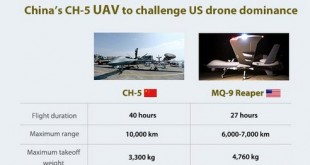As military aviation evolves, tankers and transport aircraft remain critical assets in logistics and combat support operations. However, these large, slow-moving platforms are increasingly vulnerable to threats posed by small unmanned aircraft systems (sUAS). The emergence of drone warfare, especially the use of swarms and autonomous systems, necessitates a robust on-aircraft Counter-sUAS (C-sUAS) capability to protect these assets during critical phases of flight and ground operations.
The Growing Threat of sUAS to Mobility Aircraft
Small drones present a unique and evolving threat to military aircraft. Adversaries can use them for surveillance, electronic warfare, or direct kinetic attacks. Unlike traditional threats such as surface-to-air missiles (SAMs), sUAS operate at lower altitudes, have smaller radar cross-sections, and can be deployed in large numbers to overwhelm defenses.
Transport and tanker aircraft, such as the C-130, KC-135, and C-17, typically operate in predictable flight patterns, making them prime targets. Their operations often require low-altitude maneuvers, particularly during takeoff, landing, aerial refueling, and cargo drops. These aircraft already employ defensive systems like flares, laser jammers, and electronic countermeasures against missile threats. However, they lack dedicated C-sUAS capabilities to counter the emerging drone threat effectively.
C-sUAS Requirements for On-Aircraft Defense
Threat Detection and Identification
An effective on-aircraft C-sUAS solution must be capable of detecting, tracking, and classifying sUAS threats in real time. Given the proliferation of drones in both military and civilian environments, the system must be able to differentiate between friendly, neutral, and hostile drones to prevent fratricide or accidental engagements. Advanced sensors, including radar, electro-optical/infrared, and electronic warfare systems, must work together to provide comprehensive situational awareness.
The detection and tracking system should employ multi-sensor fusion, including radar, electro-optical/infrared (EO/IR), RF scanning, and acoustic sensors, to detect both emitting and non-emitting drones. The capability to handle multiple threats simultaneously, particularly drone swarms, is critical. Advanced AI-driven threat classification should ensure accurate friend-or-foe identification, reducing false alarms and operational risks.
Engagement and Neutralization
Directed-energy weapons (DEWs), such as high-energy lasers and high-power microwaves, can provide precise and scalable effects against enemy drones. Radio-frequency jamming and spoofing techniques can disrupt an adversary’s control links or navigation systems, rendering the drone ineffective. In scenarios where kinetic solutions are necessary, physical interception mechanisms, such as airburst munitions or net-based capture systems, must be integrated. The system must be capable of engaging threats autonomously or under operator control while minimizing collateral damage, especially in civilian airspace.
Low-Altitude and Ground Operations Protection
Since the threat posed by sUAS is most significant during low-altitude operations, the C-sUAS system must be optimized for effectiveness at altitudes below 16,000 feet. During takeoff, landing, aerial refueling, and cargo drops, aircraft are at their most vulnerable, requiring a layered defense system that can rapidly detect and respond to incoming threats. Additionally, protection during ground operations, such as taxiing and parking, is equally important, particularly against loitering munitions and swarming drone attacks that may attempt to strike an aircraft before takeoff.
Integration with Existing Defensive Systems
A successful C-sUAS system must seamlessly integrate with existing aircraft survivability equipment (ASE) without imposing excessive weight, power, or computational burdens. Modular architectures that allow for interoperability with current defensive measures—such as chaff, flares, and electronic countermeasures—will ensure that the counter-drone solution complements, rather than replaces, existing aircraft protection strategies. The use of AI-driven threat assessment can further enhance decision-making and response times, ensuring that operators can prioritize threats effectively in contested airspace.Additionally, the system must be tested under realistic environmental and operational conditions to validate its effectiveness. By meeting these requirements, an airborne C-sUAS solution will provide enhanced protection for mobility aircraft, ensuring their survivability against evolving drone threats while maintaining safe and effective operations in both military and commercial airspace.
Addressing Challenges in Commercial and Military Airspace
Deploying C-sUAS capabilities on mobility aircraft introduces the complex challenge of distinguishing between commercial and adversarial drones. Misidentifying civilian UAVs could lead to unintended engagements, increasing risks in shared airspace. To address this challenge, the solution must incorporate sophisticated artificial intelligence and machine learning algorithms capable of assessing a drone’s intent based on its behavior, flight pattern, and communication signals. Additionally, geofencing and coordination with civilian air traffic management authorities could help refine the system’s identification capabilities, reducing the likelihood of false positives.
The Future of On-Aircraft C-sUAS
The development of airborne C-sUAS capabilities aligns with broader military efforts to enhance aircraft survivability in contested environments. Future iterations may integrate directed-energy weapons, advanced electronic warfare capabilities, and AI-driven autonomy to provide real-time threat response. Advances in sensor fusion, quantum radar, and machine learning algorithms could further improve detection and engagement capabilities, making these systems more effective against increasingly sophisticated drone threats.
As adversaries continue to exploit the advantages of small drone technology, tankers and transport aircraft must adapt by integrating cutting-edge C-sUAS defenses. Ensuring the survivability of these critical platforms will enhance military logistics, refueling operations, and mission success in future conflicts.
 International Defense Security & Technology Your trusted Source for News, Research and Analysis
International Defense Security & Technology Your trusted Source for News, Research and Analysis


